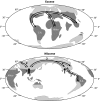Colloquium paper: a phylogenetic perspective on the distribution of plant diversity
- PMID: 18695216
- PMCID: PMC2556411
- DOI: 10.1073/pnas.0801962105
Colloquium paper: a phylogenetic perspective on the distribution of plant diversity
Abstract
Phylogenetic studies are revealing that major ecological niches are more conserved through evolutionary history than expected, implying that adaptations to major climate changes have not readily been accomplished in all lineages. Phylogenetic niche conservatism has important consequences for the assembly of both local communities and the regional species pools from which these are drawn. If corridors for movement are available, newly emerging environments will tend to be filled by species that filter in from areas in which the relevant adaptations have already evolved, as opposed to being filled by in situ evolution of these adaptations. Examples include intercontinental disjunctions of tropical plants, the spread of plant lineages around the Northern Hemisphere after the evolution of cold tolerance, and the radiation of northern alpine plants into the Andes. These observations highlight the role of phylogenetic knowledge and historical biogeography in explanations of global biodiversity patterns. They also have implications for the future of biodiversity.
Conflict of interest statement
The author declares no conflict of interest.
Figures

References
-
- Edwards EJ, Still CJ, Donoghue MJ. The relevance of phylogeny to studies of global change. Trends Ecol Evol. 2007;22:243–249. - PubMed
-
- Mayr E. Principles of Systematic Zoology. New York: McGraw–Hill; 1969.
-
- Hennig W. Phylogenetic Systematics. Urbana: Univ Illinois Press; 1966.
-
- Cronquist A. The Evolution and Classification of Flowering Plants. Boston: Houghton Mifflin; 1968.
-
- Stebbins GL. Flowering Plants: Evolution Above the Species Level. Cambridge, MA: Belknap; 1974.
Publication types
MeSH terms
LinkOut - more resources
Full Text Sources

